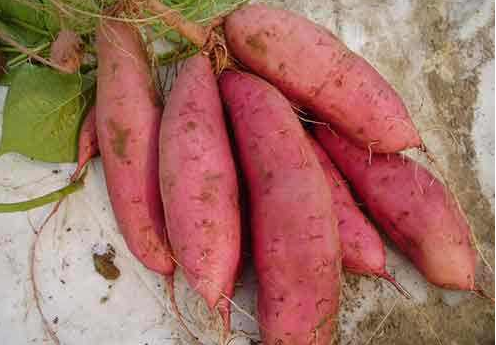The process is as follows: raw material selection - washing - crushing - grinding filtration - pulping - crucible and cylinder - pulp - powder - drying
The production process is as follows:
(1) Selection of raw materials: Because of the different varieties of sweet potatoes, their quality and starch content are also different. Even in the same variety, the quality of the same variety varies greatly. To choose a good variety of processed starch, high starch content is required. The sweet potato with disease is not only suitable for starch processing raw materials, but also will be transmitted to other potato pieces during storage, which is prone to rot and loss. Therefore, the diseased potatoes should be removed. .
(2) Washing: Pour fresh potatoes into the tank and add water, and wash them by hand. After washing, take them out and drain the remaining water.
(3) Crushing: The fresh potato after draining is broken into pieces with a crusher, and the size of the block is 2 cm or less to facilitate the grinding.

(4) Grinding filtration: This is the main link in the production of sweet potato starch, which affects product quality and starch yield. The fresh potato pieces are sent to the stone mill or the diamond sand mill to add the water to the potato paste. The ratio of the weight of the fresh potato to the amount of water added is 1:3 to 3.5. The potato paste was poured into a sieve having a pore size of 60 mesh for filtration.
(5) Pulping: The starch milk obtained by filtration is placed in a large tank, and then the acidity and concentration of the starch milk are adjusted by adding the acid slurry and water in proportion. The acidity and concentration of starch milk are closely related to the precipitation of starch and protein. If the starch lactic acid is too large, starch and protein precipitate at the same time, so that the starch is not clearly separated. If the acidity is too small, both protein and starch will not precipitate well, and it will be an emulsion and cannot be separated. According to production experience, the optimum pH of the syrup is 3.6-4.0. The concentration of starch milk in the large tank is 3.5 to 4.0 Baume, the amount of acid slurry added is 2% of starch milk, and the pH of starch milk after adding acid slurry is 5.6. If the temperature is high, the fermentation is fast, and the amount of acid slurry can be reduced.
(6) Cylinder and sitting cylinder: After the slurry is allowed to stand for about 20 to 30 minutes, the sedimentation is completed and the crucible can be carried out. The upper layer of clear water and a mixture of protein, fiber and a small amount of starch are taken out, and the starch remaining on the bottom layer. The bottom starch after the crucible is mixed with water to adjust the starch milk to reprecipitate the starch. In the precipitation process, the syrup is fermented, and it is called a cylinder. Temperature and time should be controlled when sitting in the tank. The cylinder temperature is around 20 degrees Celsius. Hot water must be used when it is cold or when it is mixed with water. The fermentation in the tank must be permeable and properly stirred during the fermentation to promote the fermentation. Generally, the tank time is 24 hours, and the daily heat can be shortened accordingly. After the fermentation is completed, the starch precipitates.
(7) Slurry filtration: The acid slurry produced by the cylinder is called the second and the slurry, that is, the acid slurry mainly used in the acid slurry method. The normal physalis of the fermentation has a clear fragrance, and the color is white as milk. If the physalis is insufficiently fermented or over-fermented, the color and the aroma are poor, and the effect is not good when used for the pulp. The mash is used to extract the upper syrup as a slurry. The starch after mashing was sieved with a fine sieve having a mesh opening of 120. The sieve top is fine slag and can be used as feed. The sieved material is starch and transferred to a small cylinder. After the starch is transferred to the small tank, the starch is rinsed with water and placed for about 24 hours to prevent fermentation.
(8) Starting powder: After the starch is precipitated in a small tank, the upper liquid is a small slurry, which can be used together with the acid slurry or as a grinding water. After removing the syrup, a layer of gray oil powder is left on the surface of the starch, which is an impure starch containing protein. The oil powder can be washed away from the surface of the starch with water. The washing liquid can be used as a nutrient material for culturing the acid syrup. The bottom starch is removed with a shovel, and the bottom of the starch may have fine sand adhered, which should be brushed off.
(9) Drying: After the above procedure, wet starch was obtained. Drying is necessary to facilitate storage and transportation. It is usually dried in the sun or sent to the drying room for drying.
COVID-19 Antigen Rapid Test-nasal Swab
Covid-19 Antigen Rapid Test-Nasal Swab,Covid-19 Antigen Rapid Test With Swab,Covid 19 Antigen Pre-Nasal Test Cassette,Medical Detection Covid-19 Rapid Test Kit
Weihai Kangzhou Biotechnology Engineering Co.,Ltd , https://www.weihaikangzhou.com